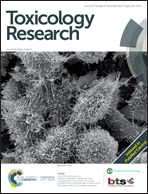Astaxanthin reduces perfluorooctanoic acid cytotoxicity in Saccharomyces cerevisiae
Abstract
Perfluorooctanoic acid (PFA) has been identified as an environmental contaminant of high concern for human health. In this study, we demonstrated that PFA induces a dose (0 to 1.5 mM) dependent cytotoxicity in S. cerevisiae cells which can be rescued by astaxanthin. The percent sensitivity induced by PFA and the cell protection offered by astaxanthin (30 μM) were demonstrated by CFU counts and spots. The increase in intracellular ROS, superoxide dismutase (SOD), glutathione and lipid peroxidation levels in PFA treated cells suggested that increased oxidative stress resulted in yeast cell death. In contrast, decreased ROS level, increased SOD activity, reduced glutathione and decreased lipid peroxidation by astaxanthin supplementation suggest that the cells are protected from the PFA induced oxidative stress mediated cytotoxicity. Reduced chromatin condensation and nuclear fragmentation in astaxanthin pre-treated cells indicate that astaxanthin rescued the cells from PFA induced apoptosis. Our overall results suggest that PFA induces oxidative stress-mediated cytotoxicity in yeast cells, which were rescued by astaxanthin treatment.



 Please wait while we load your content...
Please wait while we load your content...